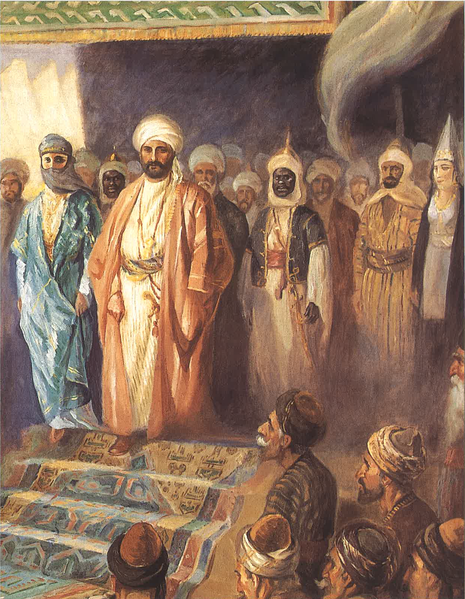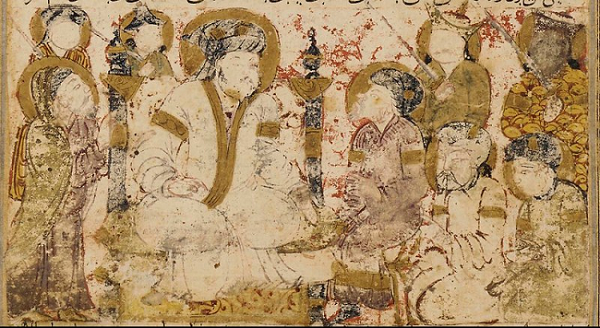

After the death of the prophet Muhammad (the last messenger of Islam) in 632 AD, the authority of the Muslim world came into the hands of the Rashidun caliphate, the four Rashidun caliphate Abu Bakr, Umar, Uthman, and Ali ruled the Muslim world for 30 years. After various political disagreements, the Umayyad dynasty came into being and ruled the Muslim world until 750 AD.

Muawiya Talking to Sea
Moustafa Farroukh, Public domain, via Wikimedia Commons
The rule of Ummayads started with the caliph Muawiya one of the companions of the prophet Muhammad, the Muawiya came into power by agreeing with Hasan ibn Ali, the son of Ali (the husband of the daughter of Prophet Muhammad). The treaty between Hasan and Muawiya was breached by the son of Muawiya named Yazid. The Brother of Hasan named Hussain did not accept the authority of Yazid and in this struggle, Hussain was assassinated. The Ummayad rule ended with the last caliphate Marwan 2, who died in Abbasid Revolution.
The Abbasids trace their ancestry from Abbas ibn al Muttalib the youngest uncle of the prophet Muhammad, the idea behind the Abbasid revolution was to take the authority of the Muslim world into the hand of the family of the prophet Muhammad(although the direct descendent of Muhammad was not given power after the revolution).
The Abbasids has been vocal during the last decades of the Ummayad dynasty, they were vocal about the bad governance of Umayyads, Abbasids has been aided by the Shia Muslims as they believed that the rightful authority of the Muslim world should belong to the decedents of the prophet Muhammad.

Umayyad Caliphate 750 AD
Ergovius, CC BY-SA 4.0
The propaganda of Abbasid alarmed the Ummayd caliph Marwa 2, he ordered the execution of the head of the Abbasid clan, Ibrahim. The assassination of Ibrahim gave the reason for the Abbasid army to attack the Ummayad Caliphate. Abu Abbas(the brother of Ibrahim) mobilized his army and attacked the Ummayads, the Ummayds fled, and Abbasid proclaimed Abu Abbas as the caliph in the Kufa.
Many reasons led to the overthrow of the Ummayad caliphate and the establishment of the Abbasid caliphate through revolution.
The discontent among the Shia Muslims - After the battle of Karbala (where Hussain Ibn Ali was the rightful successor of Muslim authority, according to the Shia school of thought) the Shia Muslims developed discontent against the Sunni Ummayad caliphate, the Umayyad caliphate has marginalized the decedents of prophet Muhammad from the Muslim polity.
Alienation of non-Arab - The Ummayad rule was centred around Damascus, the most prominent city of the Arabs at that time, the ruling elites of the Ummayad caliphate were all Arabs, and the Arabian language and culture were given prominence over other cultures. This has led to alienation and discontent among the newly converted non-Arab population such as Persians and Byzantines.
Persecution of non-muslims - The non-Muslim population, primarily the Syrian Christians, Jews, and Zoroastrians were perceived in the Ummayad rule.
While the discontent among the Shia Muslims, non-Arabs, and non-Muslims was building up, this was the time for the Abbasids to cultivate discontent into overthrowing the Ummayad caliphate.
The most prominent person in setting the revolution was Persian general Abu Muslim, he met the Shia leaders in the Kufa (Kufa was the centre of rebellion). The Abu Muslim finally met Ibrahim the leader of the Abbasid clan in Mecca. The Abbasid along with other Hashmi tribes started plotting the revolution, and the underground secret mission of overthrowing the caliphate was building up. The Abbasid has made a coalition with the eastern newly converted Muslims. The rebellion also spread in the western part(North Africa) of the Caliphate, the Berber revolt.

Balami - Tarikhnama - Abu'l-'Abbas al-Saffah is proclaimed the first 'Abbasid Caliph
Muhammad Bal'ami, Public domain, via Wikimedia Commons
The final nail in the coffin of the Ummayad caliphate struck when the forces of Abbasids and the forces of Ummayads meet at the River Zab, the decisive battle is known as the battle of Zab. The battle lasted for 9 days and the army of Ummayad was completely defeated. The Marwan 2 fled to Egypt and were killed by the force of Abbasid
The Abbasid dynasty is known for consolidating the Caliphate and developing art, culture, science, astronomy, physics, and philosophy.
Apart from this, the Abbasid caliphate is also known for the construction of a new city known as Baghdad which still exists and is currently the capital of Iraq. The city of Baghdad is situated between the right and left sides of the bank of the river Tigris.
The most important contribution of the Abbasid is what is today known as the “golden age of Islam”, the reason it is called the golden age is because of the development of the knowledge centre. Harun al Rashid, the caliph of the Abbasid dynasty, was known for the construction of the House of Wisdom in Baghdad. The house of wisdom was the intellectual centre of that time, the house of wisdom has libraries, research centres, and a place for intellectual debates.
The development of Al-zebra, astronomy, and physics is said to take place in this age. The Abbasids patronized Persian culture, and the development of Persian culture throughout the eastern side of the empire because of the caliphate.
After the death of the prophet Muhammad, there were civil wars among the different elites of the early Islamic period, the two main groups known as Shia and Sunni emerged, the Sunnis were believed to be the followers of the Quran, Hadit, and the “rightly guided” four Rashid caliphs, Abu Bakr, Umar, Usman, and Ali. While Shia believes that instead of the Caliphate system, the Imamate system should be the sole authority of the Muslims, the imamate should belong to the family of the prophet Muhammad. The Ummayad came after the end of the Rashidun Caliphate, the Ummayad dynasty lasted till 750 AD and was overthrown in a bloody revolution. The Abbasids consolidated their empire and shifted inward to develop science, arts, and literature.
Q1. Who was the prophet, Muhammad?
Ans. The prophet Muhammad is believed by Muslims as the last messenger of Allah(god). The prophet was born in 532 AD in Macca. The prophethood came to Muhammad when he was at the age of 40. The angel recited the verses of the Quran to the Prophet Muhammad.
Q2. Name other major caliphates that existed since the death of Muhammad.
Ans. The first major caliphate was Rashidun Caliphate. Another major caliphate was Ummayad caliphate, the Abbasid caliphate, and the Ottoman empire.
Q3. During the time of which caliphate did Arabs invade Sindh?
Ans. During the time of the Umayyad caliphate in 712 AD, the general of Ummayad known as Muhammad bin Qasim attacked Sindh.
Q4. Which empire succeeded the Abbasid caliphate?
Ans. The rise of the Seljuk dynasty shrunk the space for the Abbasids, the caliphate was restricted to the city of Baghdad in the later period, and the final nail in the coffin was struck by the Mongols when they sacked Baghdad in 1258 AD.